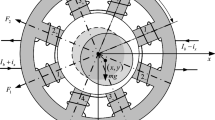Abstract
A model predictive optimal control method for magnetically suspended flywheel is presented. In order to suppress the conical whirl of the rotor caused by gyroscopic effect, the synchronization error is added to the traditional quadratic performance index. The target performance index is composed of the translatory error, the synchronization error, and the control output predicted by the discrete-time state model. The optimal controller is obtained by means of iterating a Riccati difference equation (RDE). Stability of the control scheme is investigated through fake algebraic Riccati technique (FART). The robust performance of the controller with respect to control parameters is studied by simulation. Results of the simulation and experiment on a compact magnetically suspended flywheel demonstrate that the proposed controller with consideration of the synchronization error is very effective to suppress the conical whirl caused by gyroscopic effect.
Similar content being viewed by others
References
Wang X, Fang J C, Fan Y H, et al. Axial force tilting permanent-magnet-biased magnetic bearing with five degrees of freedom and magnetic field decoupling design (in Chinese). In: Proceedings of the CSEE, 2011, 31(17): 91–96
Fang J C, Sun J J, Xu Y L, et al. A new structure for permanent-magnet-biased axial hybrid magnetic bearings. IEEE T Magn, 2009, 45(2): 5319–5325
Fang J C, Ren Y. High-precision control for a single-gimbal magnetically suspended control moment gyro based on inverse system method. IEEE T Ind Electron, 2011, 58(9): 4331–4342
Sun Y K, Zhu Z Y. Inverse-model identification and decoupling control based on least squares support vector machine for 3 degree-of-freedom hybrid magnetic bearing (in Chinese). In: Proceedings of the CSEE, 2010, 30(15): 112–117
Zhang D H, Chen J H, Su Y X, et al. Fuzzy inverse modeling for active magnetic bearing systems (in Chinese). In: Proceedings of the CSEE, 2006, 26(14): 126–130
Sun Y K, Fei D C, Zhu H Q. Study on decoupling control of the 5 degree-of-freedom bearingless permanent magnet motor based on α-th order inverse system method (in Chinese). In: Proceedings of the CSEE, 2006, 26(1): 120–126
Markus A, Ladislav K, Rene L. Performance of a magnetically suspended flywheel energy storage device. IEEE T Contr Sys Tech, 1996, 4(5): 494–501
Zhao L, Zhang K, Zhu R S, et al. Experimental research on a momentum wheel suspended by active magnetic bearings. In: Proceedings of the 8th International Symposium on Magnetic Bearings. Mito, Japan, 2002. 605–609
Zhuravlyov Y N. On LQ-control of magnetic bearing. IEEE T Contr Sys Tech, 2000, 8(2): 344–350
Park J Y, Palazzolo A, Beach R. MIMO active vibration control of magnetically suspended flywheels for satellite IPAC service. J Dyn Syst Meas Contr, 2008, 130(7): 501–522
Grega W, Piłat A. Comparison of linear control methods for an AMB system. Int J Appl Math Comput Sci, 2005, 15(2): 245–255
Jastrzebski R P. Design and implementation of FPGA-based LQ control of active magnetic bearings. PhD Thesis. Lappeenranta, Finland: Lappeenranta University of Technology, 2007. 40–65
Kim C S, Lee C W. Isotropic optimal control of active magnetic bearing system. In: Proceedings of the 4th International Symposium on Magnetic Bearings, Zurich, Switzerland, 1994. 35–40
Kucera V. The discrete Riccati equation of optimal control. Kybernetica, Prague, 1972, 8(5): 430–447
Pappas T, Laub A J, Sandell N R. On the numerical solution of the discrete-time algebraic Riccatic equation. IEEE T Automat Contr, 1980, AC-25(4): 631–641
Emami N A, Franklin G F. Dead beat control and tracking of discrete time systems. IEEE T Automat Contr, 1982, AC-27(1): 176–181
Callier F M, Willems J L. Criterion for the convergence of the solution of the Riccati difference equation. IEEE T Automat Contr, 1981, AC-26(6): 1232–1242
Chan S C, Goodwin G C, Sin K S. Convergence properties of the Riccati difference equation in optimal filtering of nonstabilizable systems. IEEE T Automat Contr, 1984, AC-29(2): 110–118
Souza C E, Gevers M, Goodwin G C. Riccati equations in optimal filtering of nonstabilizable systems having singular state transition matrices. IEEE T Automat Contr, 1986, AC-31(9): 831–837
Zhu K Y, Chen B P. Cross-coupling design of generalized predictive control with reference models. In: Proc IMechE Part I: J Syst Control Eng, 2001, 215(3): 75–84
Author information
Authors and Affiliations
Corresponding author
Rights and permissions
About this article
Cite this article
Zhang, L., Liu, K. Riccati difference equation in optimal control for magnetic bearings. Sci. China Technol. Sci. 55, 2107–2114 (2012). https://doi.org/10.1007/s11431-012-4926-2
Received:
Accepted:
Published:
Issue Date:
DOI: https://doi.org/10.1007/s11431-012-4926-2



